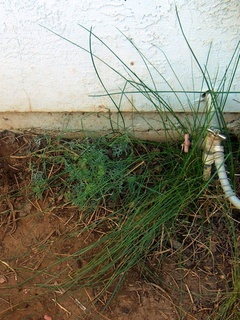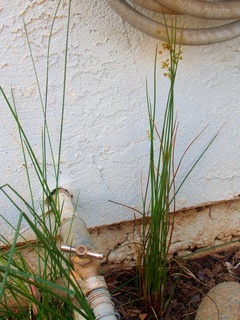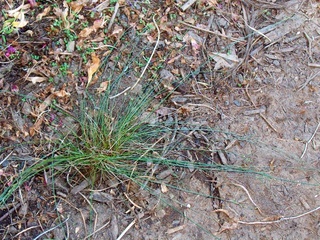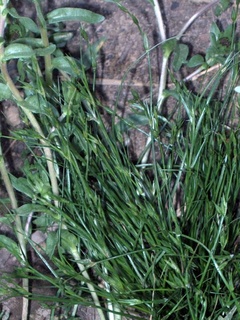Rushes are annual or perennial grasslike plants in the rush family. In general, rushes tend to prefer more water than grasses and sedges and to be more evergreen than grasses and sedges. Most rushes are either usually or always found in wetlands, although woodrushes (in the genus Luzula) tend to require somewhat less water than other rushes (in the genus Juncus). Many rushes are native to the Yuba-Sutter area.
Perennials
Wire Rush
 Wire rush (Juncus balticus) next to an outdoor faucet in Marysville. Photo by queerbychoice. Wire rush (also called Baltic rush) is a two- to three-foot-tall rush that is native to Yuba and Sutter Counties and typically grows at elevations below 11,000 feet. It is found in central oak woodland, valley grassland, yellow pine forest, and riparian forest. It tolerates sand and clay.
Wire rush (Juncus balticus) next to an outdoor faucet in Marysville. Photo by queerbychoice. Wire rush (also called Baltic rush) is a two- to three-foot-tall rush that is native to Yuba and Sutter Counties and typically grows at elevations below 11,000 feet. It is found in central oak woodland, valley grassland, yellow pine forest, and riparian forest. It tolerates sand and clay.
You can read more about it at the Las Pilitas Nursery website. You can see pictures of it at CalPhotos, Flickr, and Picasa. You can find out where to buy it at the California Native Plant Link Exchange.
Mexican Rush
Mexican rush is a one- to two-foot-tall, evergreen rush that is native to Sutter County and typically grows at elevations below 11,000 feet. It is found in central oak woodland, valley grassland, yellow pine forest, and riparian forest. It tolerates clay.
You can read more about it at the Theodore Payne Wiki and USDA Conservation Plant Characteristics. You can see pictures of it at CalPhotos, Flickr, and Picasa. You can find out where to buy it at the California Native Plant Link Exchange.
Common Bog Rush
 Common bog rush (Juncus effusus) next to an outdoor faucet in Marysville. Common bog rush is to the right of the faucet, while wire rush (Juncus balticus) is to the left of it. Photo by queerbychoice. Common bog rush is a one- to three-foot-tall, evergreen rush that is native to Yuba and Sutter Counties and typically grows at elevations below 7,000 feet. It is found in central oak woodland, valley grassland, yellow pine forest, and riparian forest. It tolerates sand and clay. Botanist Willis Linn Jepson collected common bog rush in Marysville in 1934.1
Common bog rush (Juncus effusus) next to an outdoor faucet in Marysville. Common bog rush is to the right of the faucet, while wire rush (Juncus balticus) is to the left of it. Photo by queerbychoice. Common bog rush is a one- to three-foot-tall, evergreen rush that is native to Yuba and Sutter Counties and typically grows at elevations below 7,000 feet. It is found in central oak woodland, valley grassland, yellow pine forest, and riparian forest. It tolerates sand and clay. Botanist Willis Linn Jepson collected common bog rush in Marysville in 1934.1
You can read more about it at the Theodore Payne Wiki, the Las Pilitas Nursery website, and USDA Conservation Plant Characteristics. You can see pictures of it at CalPhotos, Flickr, and Picasa. You can find out where to buy it at the California Native Plant Link Exchange.
Irisleaf Rush
Irisleaf rush is a one- to three-foot-tall, evergreen rush that is native to Yuba and Sutter Counties and typically grows at elevations below 7,000 feet. It is found in central oak woodland, valley grassland, yellow pine forest, and riparian forest. It tolerates shade.
You can read more about it at the Theodore Payne Wiki and the Las Pilitas Nursery website. You can see pictures of it at CalPhotos, Flickr, and Picasa. You can find out where to buy it at the California Native Plant Link Exchange.
Pacific Hairy Woodrush
Pacific hairy woodrush is native to Yuba and Sutter Counties and typically grows at elevations below 10,500 feet. It is most often found in meadows and on slopes in central oak woodland, yellow pine forest, or riparian forest. It is equally likely to grow in wetlands or non-wetlands.
You can see pictures of it at CalPhotos, Flickr, and Picasa. You can find out where to buy it at the California Native Plant Link Exchange.
Poverty Rush
 Poverty rush (Juncus tenuis) in a garden in Marysville. Photo by queerbychoice. Poverty rush is a one-and-a-half-foot-tall rush that is native to Yuba and Sutter Counties and typically grows at elevations below 7,000 feet. It is found in central oak woodland, yellow pine forest, or riparian forest. It tolerates sand, clay, and partial shade.
Poverty rush (Juncus tenuis) in a garden in Marysville. Photo by queerbychoice. Poverty rush is a one-and-a-half-foot-tall rush that is native to Yuba and Sutter Counties and typically grows at elevations below 7,000 feet. It is found in central oak woodland, yellow pine forest, or riparian forest. It tolerates sand, clay, and partial shade.
You can read more about it at USDA Conservation Plant Characteristics. You can see pictures of it at CalPhotos, Flickr, and Picasa. You can find out where to buy it at the California Native Plant Link Exchange.
Mariposa Rush
Mariposa rush is a one- to four-foot-tall rush that is native to Yuba County and typically grows at elevations below 11,000 feet. It is found in yellow pine forest or riparian forest. It tolerates sand.
You can read more about it at the Las Pilitas Nursery website. You can see pictures of it at CalPhotos, Flickr, and Picasa. You can find out where to buy it at the California Native Plant Link Exchange.
Coville's Rush
Coville's rush is native to Yuba County and typically grows at elevations below 9,800 feet. It is found in yellow pine forest or riparian forest.
You can see pictures of it at CalPhotos, Flickr, and Picasa.
Swordleaf Rush
Swordleaf rush (also called three-stamen rush or three-stem rush) is a two-foot-tall rush that is native to Yuba County and typically grows at elevations below 9,000 feet. It is found in yellow pine forest or riparian forest. It tolerates sand, clay, and partial shade.
You can read more about it at USDA Conservation Plant Characteristics. You can see pictures of it at CalPhotos, Flickr, and Picasa. You can find out where to buy it at the California Native Plant Link Exchange.
Howell's Rush
Howell's rush is native to Yuba County and typically grows at elevations between 3,000 and 7,500 feet. It is found in yellow pine forest.
You can see pictures of it at CalPhotos, Flickr, and Picasa.
Smallflower Woodrush
Smallflower woodrush is a two-foot-tall rush that is native to Yuba County and typically grows at elevations between 3,500 and 11,000 feet. It is found in yellow pine forest and riparian forest. It tolerates full shade. It is equally likely to grow in wetlands or non-wetlands.
You can read more about it at USDA Conservation Plant Characteristics. You can see pictures of it at CalPhotos, Flickr, and Picasa. You can find out where to buy it at the California Native Plant Link Exchange.
Straightleaf Rush
Straightleaf rush is native to Yuba County and typically grows at elevations between 4,000 and 11,000 feet. It is found in yellow pine forest or riparian forest.
You can see pictures of it at CalPhotos, Flickr, and Picasa. You can find out where to buy it at the California Native Plant Link Exchange.
Pointed Rush
Pointed rush is a two- to three-foot-tall by two- to three-foot-wide, stress-deciduous rush that is native to Yuba and Sutter Counties and typically grows at elevations below 7,000 feet. It is found in riparian forest. It tolerates clay.
You can read more about it at the Theodore Payne Wiki and the Las Pilitas Nursery website. You can see pictures of it at CalPhotos, Flickr, and Picasa. You can find out where to buy it at the California Native Plant Link Exchange.
Tapertip Rush
Tapertip rush (also called sharpfruit rush) is a three-foot-tall rush that is native to Yuba County. It is found in riparian forest. It tolerates sand, clay, and partial shade. Botanist Willis Linn Jepson collected tapertip rush in Smartsville in 1934.2
You can read more about it at USDA Conservation Plant Characteristics. You can see pictures of it at CalPhotos, Flickr, and Picasa. You can find out where to buy it at the California Native Plant Link Exchange.
Jointleaf Rush
Jointleaf rush is a two-foot-tall rush that is native to Yuba County. It is found in riparian forest. It tolerates sand, clay, and partial shade.
You can read more about it at USDA Conservation Plant Characteristics. You can see pictures of it at CalPhotos, Flickr, and Picasa. You can find out where to buy it at the California Native Plant Link Exchange.
Western Rush
Western rush is a two-foot-tall rush that is native to Yuba County. It is found in riparian forest.
You can read more about it at the Las Pilitas Nursery website. You can see pictures of it at CalPhotos, Flickr, and Picasa. You can find out where to buy it at the California Native Plant Link Exchange.
Brownhead Rush
Brownhead rush is a one-foot-tall rush that is native to Sutter County. It is found in riparian forest. It tolerates clay.
You can read more about it at the Las Pilitas Nursery website. You can see pictures of it at CalPhotos, Flickr, and Picasa. You can find out where to buy it at the California Native Plant Link Exchange.
Annuals
Toad Rush
 Toad rush (Juncus bufonius) volunteers in a Marysville back yard in early spring. Photo by queerbychoice. Toad rush is a one- to twelve-inch-tall rush that is native to Yuba and Sutter Counties. It is found in riparian forest and freshwater marsh. It tolerates sand and clay but not shade.
Toad rush (Juncus bufonius) volunteers in a Marysville back yard in early spring. Photo by queerbychoice. Toad rush is a one- to twelve-inch-tall rush that is native to Yuba and Sutter Counties. It is found in riparian forest and freshwater marsh. It tolerates sand and clay but not shade.
You can read more about it at USDA Conservation Plant Characteristics. You can see pictures of it at CalPhotos, Flickr, and Picasa. You can find out where to buy it at the California Native Plant Link Exchange.
Inch-High Dwarf Rush
Inch-high dwarf rush (also called twelfth rush) is native to Yuba and Sutter Counties and typically grows at elevations below 4,500 feet. It is found in riparian forest and freshwater marsh.
You can see pictures of it at CalPhotos, Flickr, and Picasa.
Dwarf Rush
Dwarf rush is native to Yuba County and typically grows at elevations below 10,600 feet. It is found in riparian forest and freshwater marsh.
You can see pictures of it at CalPhotos, Flickr, and Picasa.
Red Bluff Dwarf Rush
Red Bluff dwarf rush is native to Yuba County. It is found in riparian forest and freshwater marsh.
You can see pictures of it at CalPhotos, Flickr, and Picasa.
Footnotes
1. Consortium of California Herbaria
2. Consortium of California Herbaria


